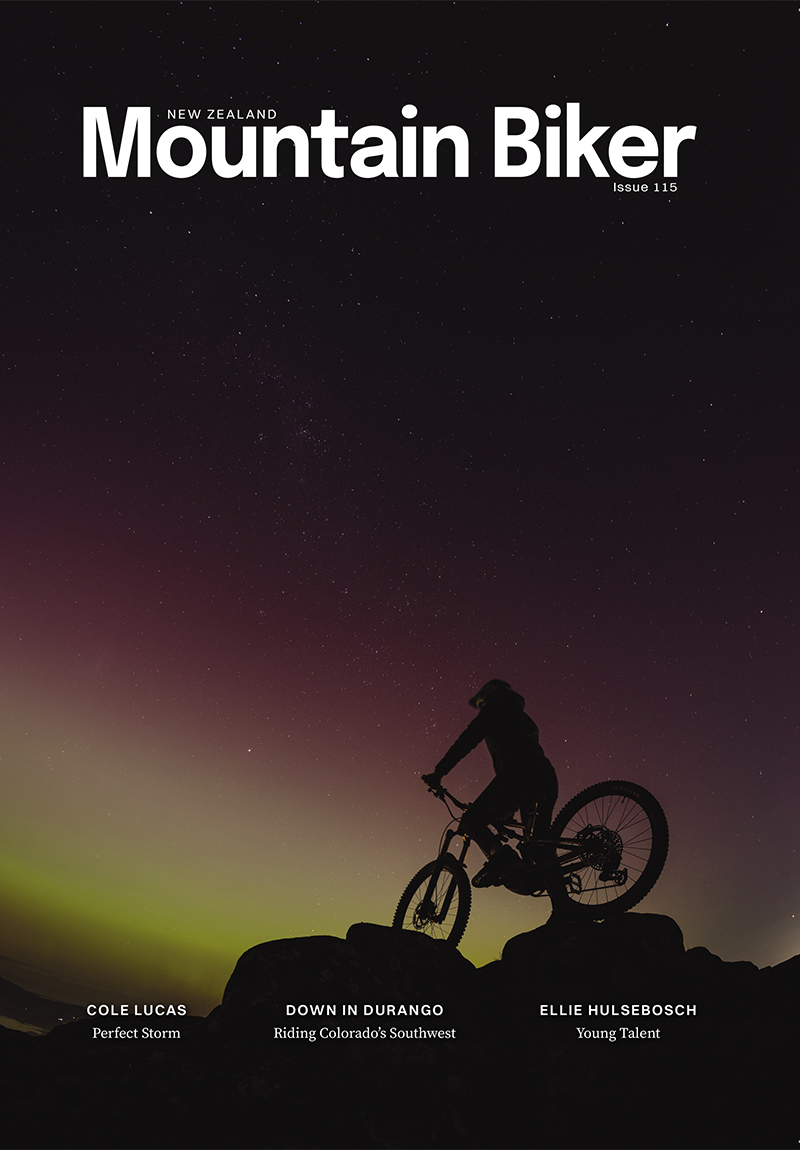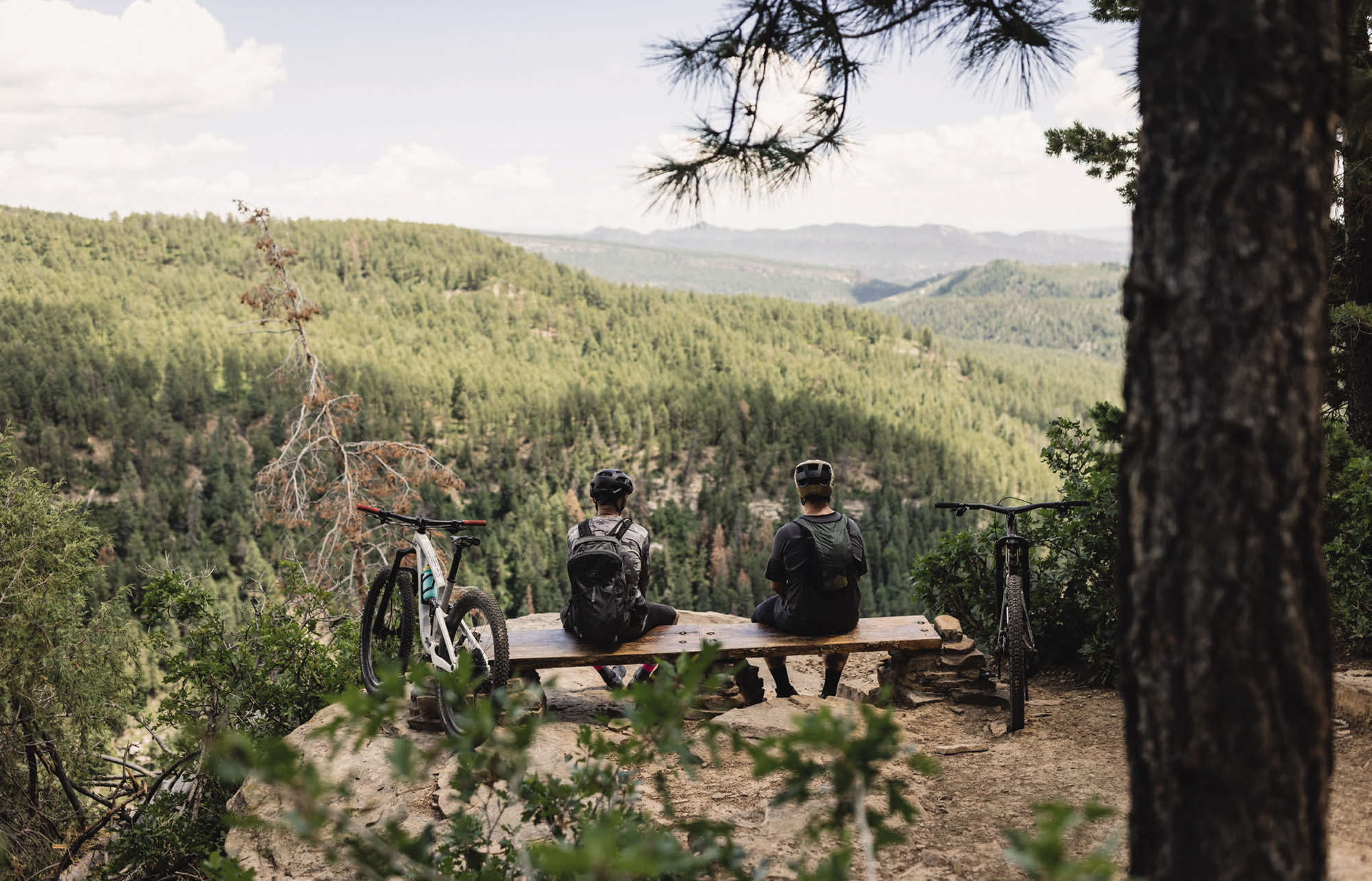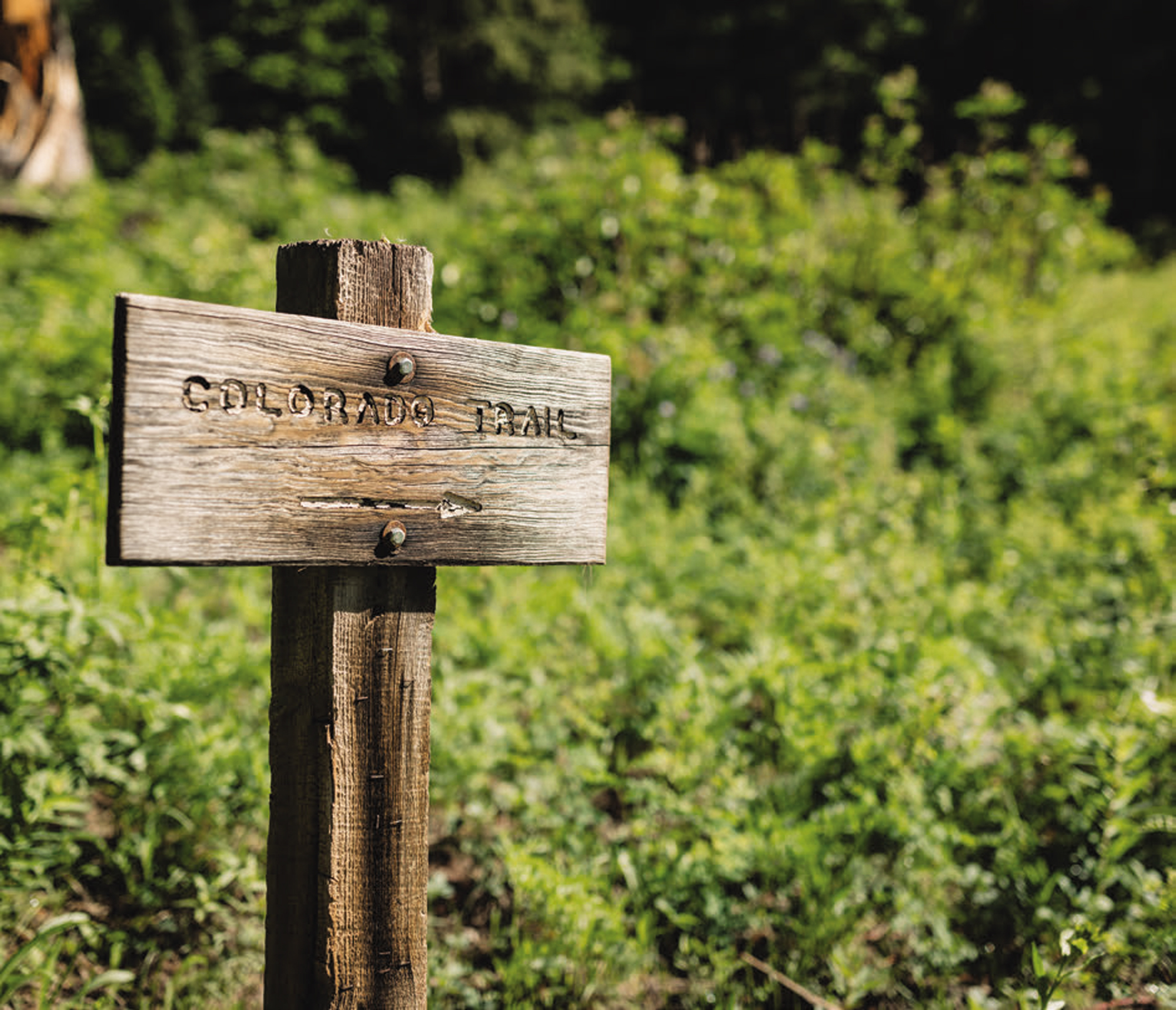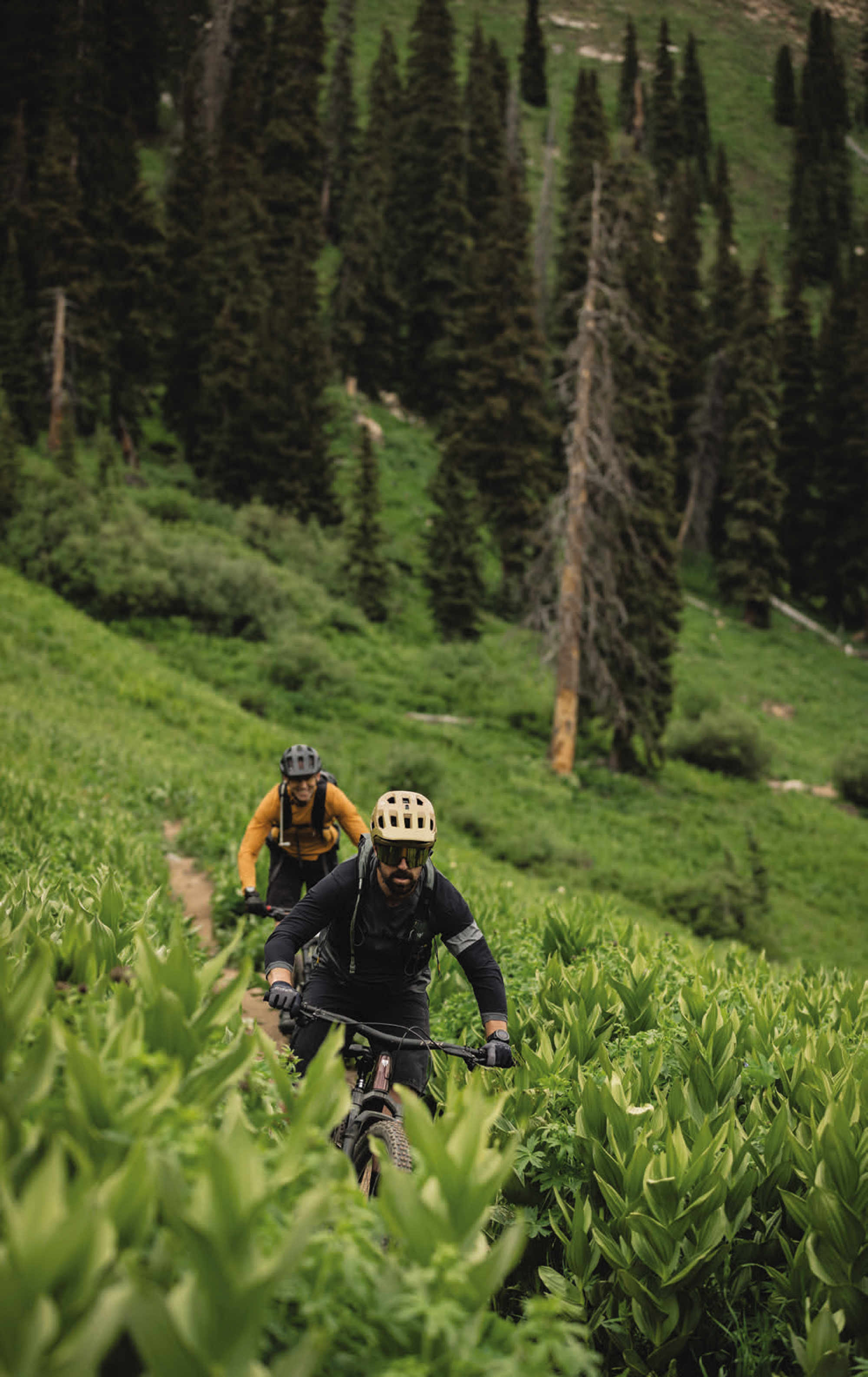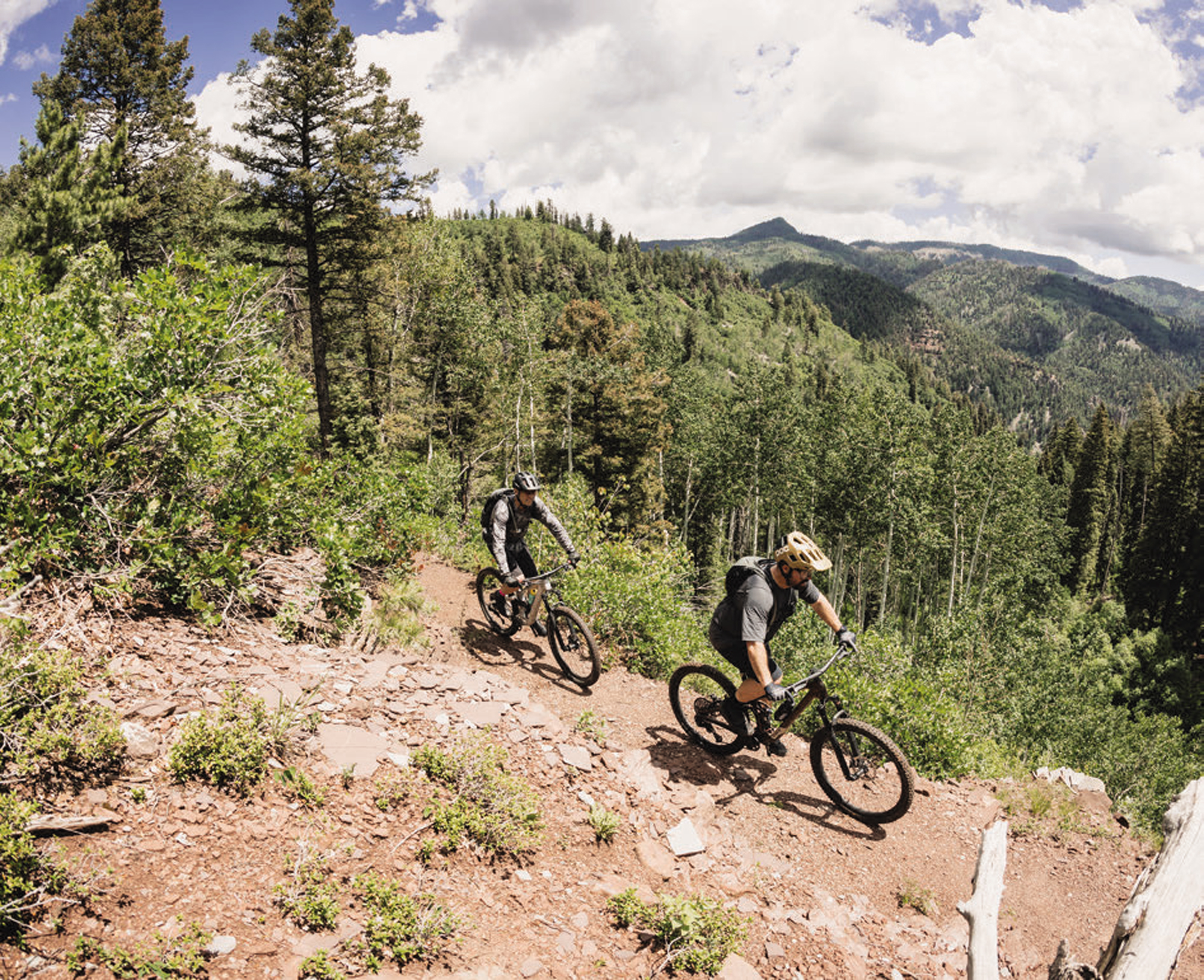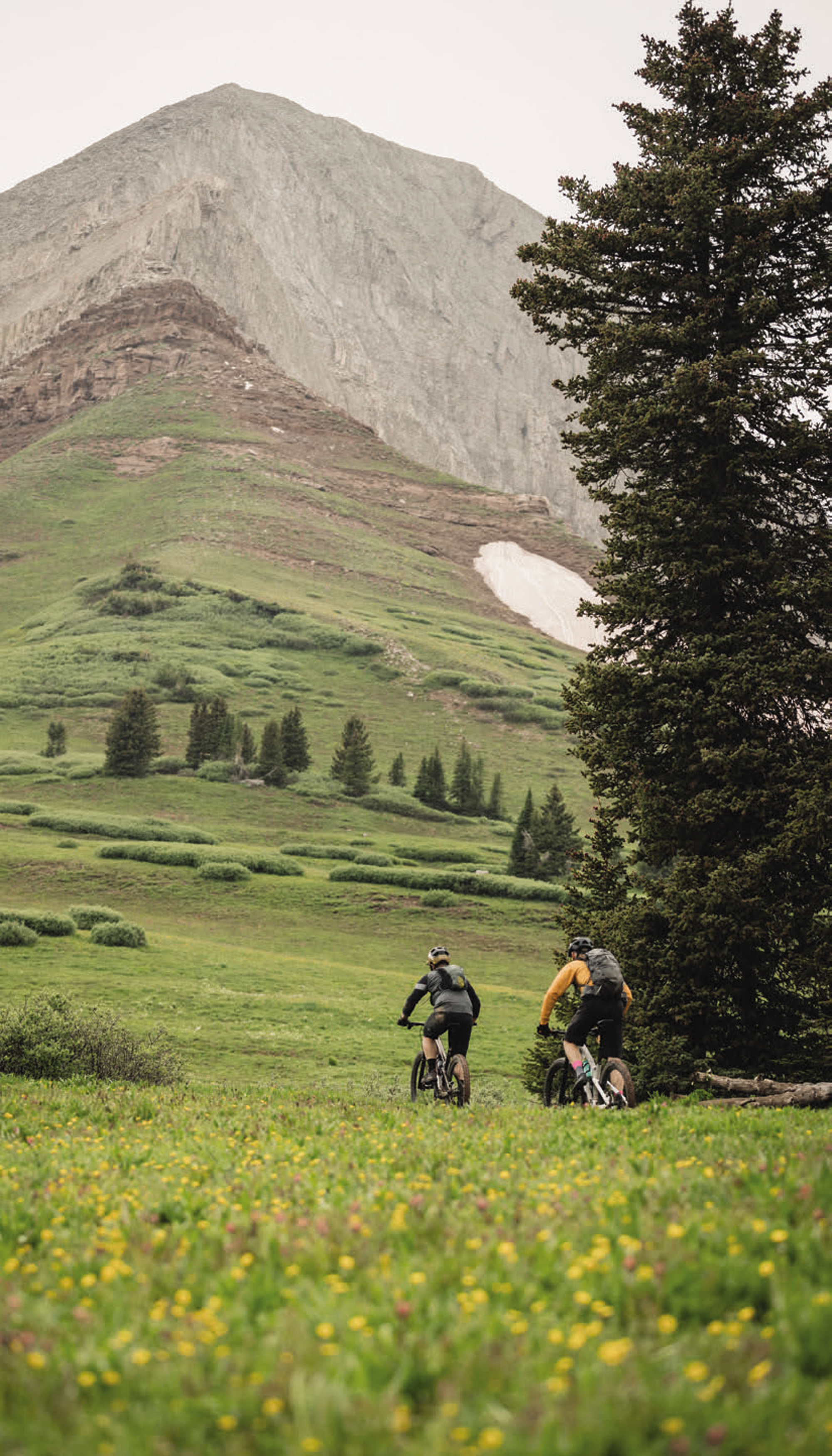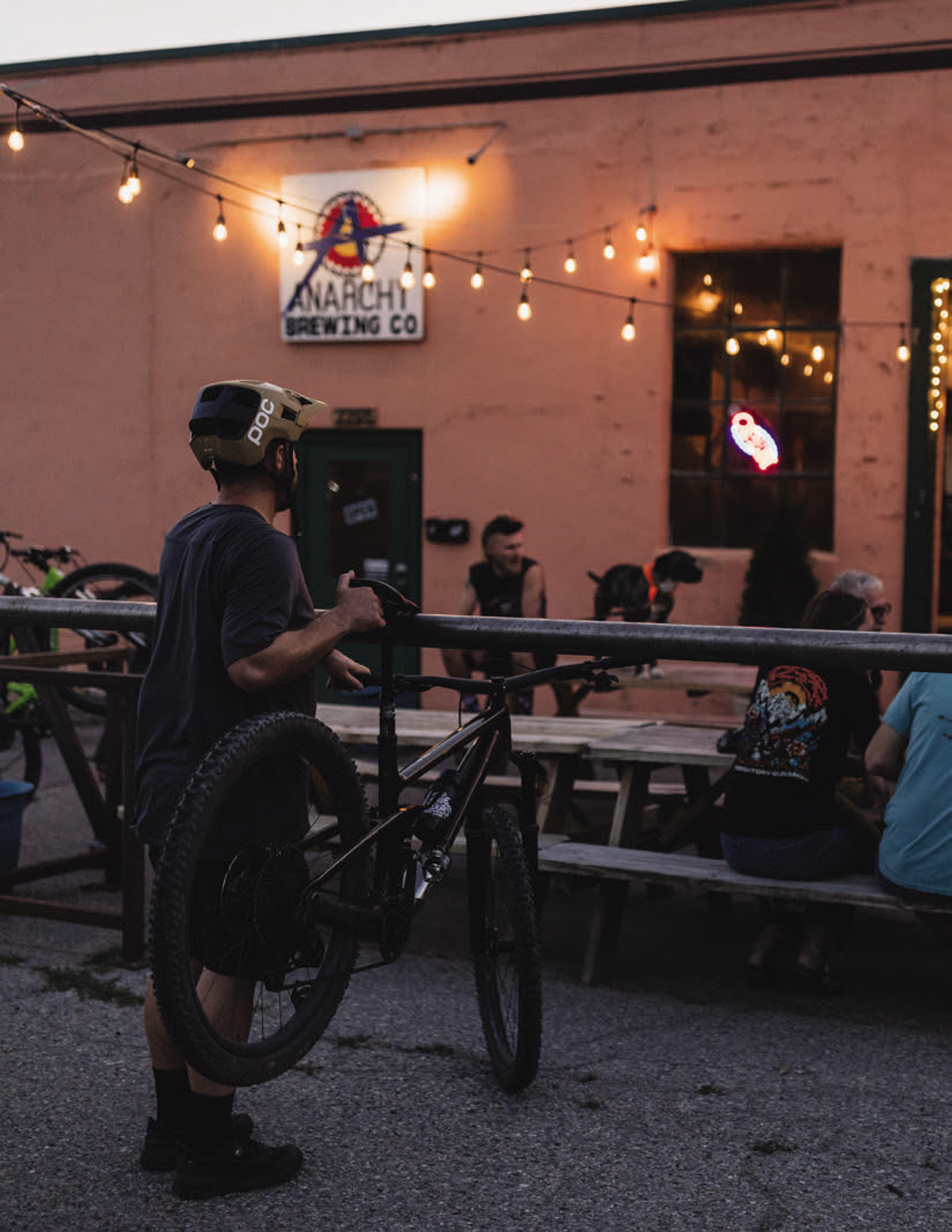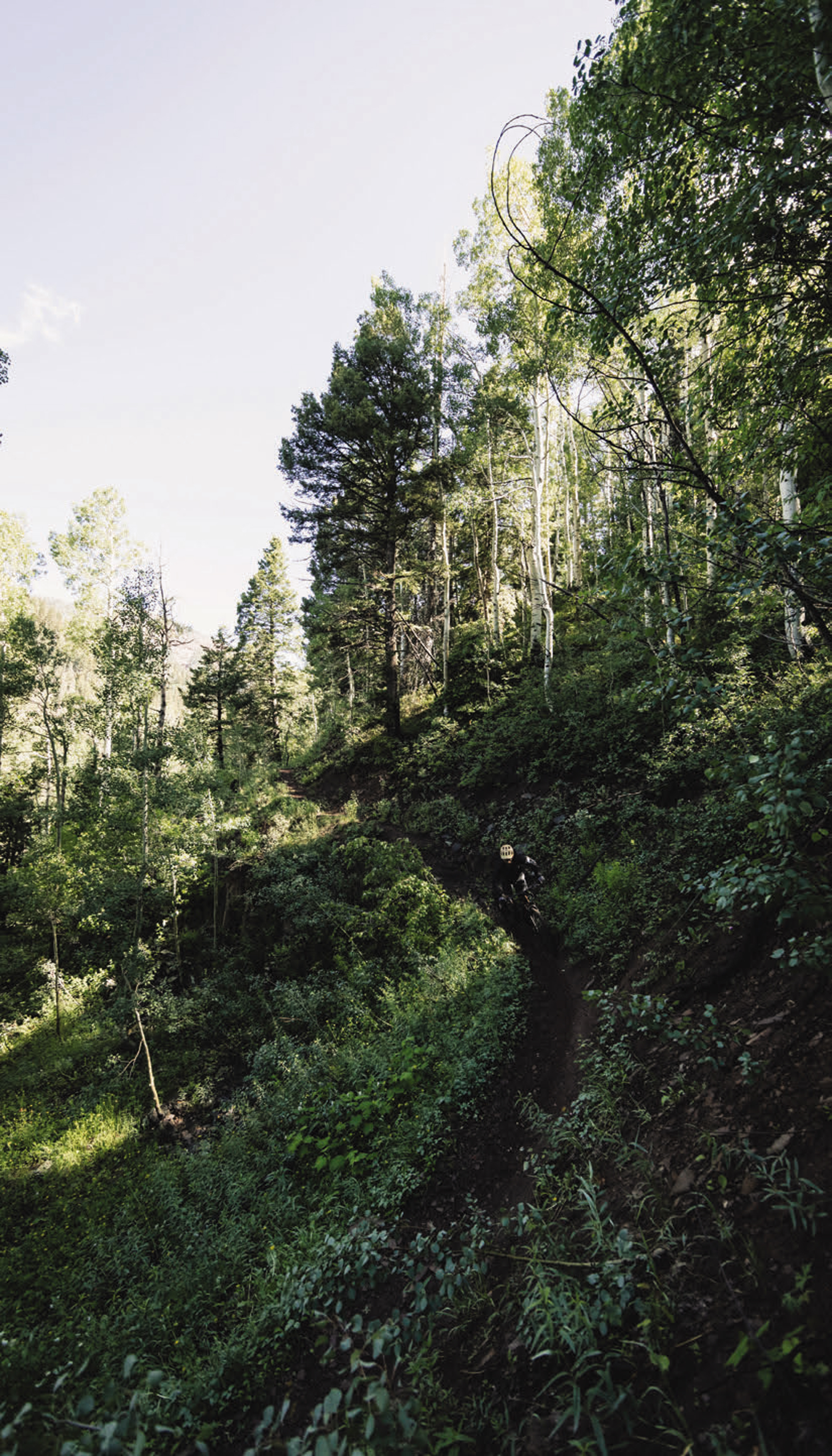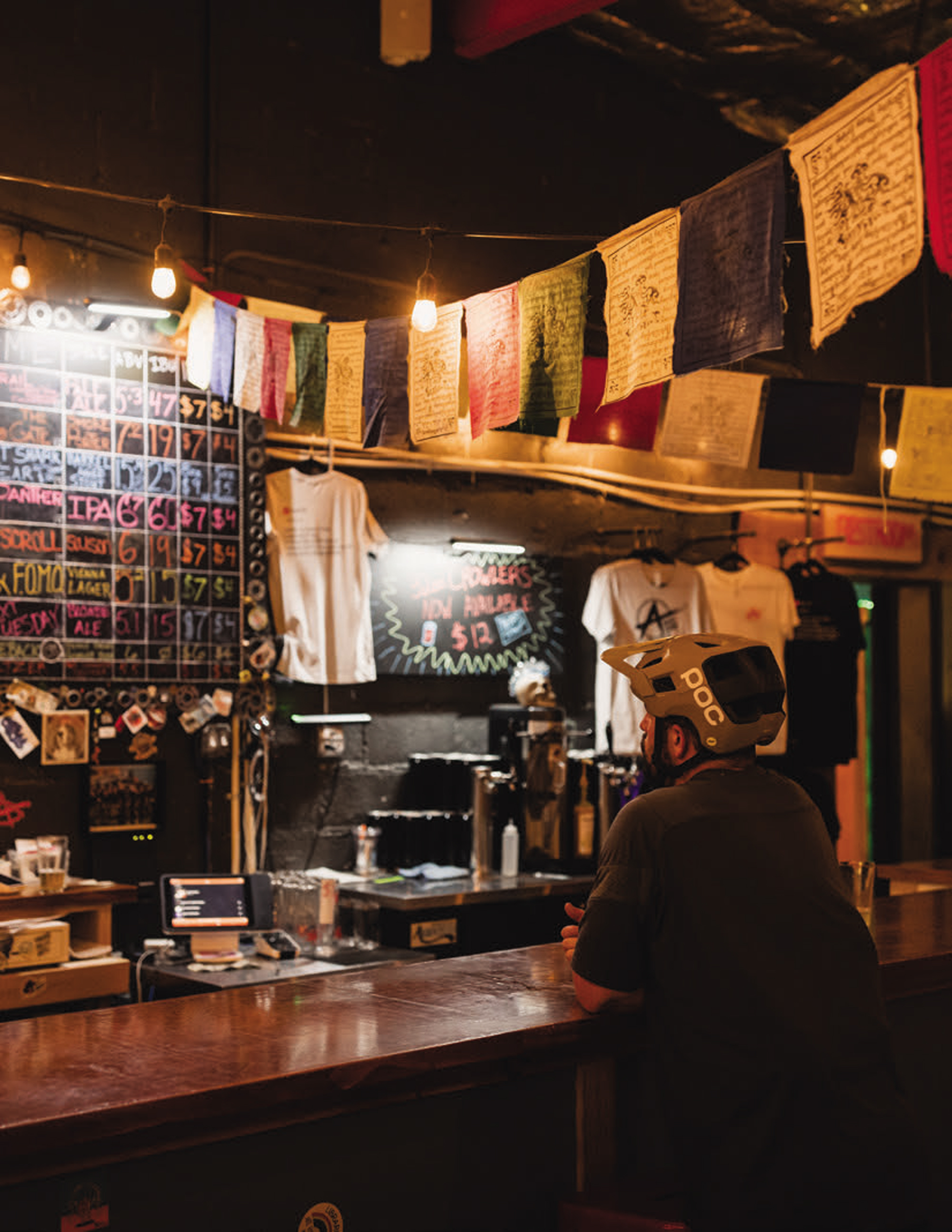Words Liam Friary
Images Cameron MacKenzie
URANGO, COLORADO, IS A TOWN STEEPED IN RICH HISTORY AND VIBRANT CULTURE. ORIGINALLY ESTABLISHED AS A MINING TOWN IN THE LATE 19TH CENTURY, DURANGO’S PAST IS STILL VISIBLE IN ITS WELL-PRESERVED VICTORIAN ARCHITECTURE AND THE NARROW- GAUGE RAILROAD THAT ONCE TRANSPORTED PRECIOUS METALS FROM THE MOUNTAINS. NOWADAYS, HOWEVER, THE TOWN HAS EVOLVED FAR BEYOND ITS MINING ROOTS TO BECOME A MECCA FOR OUTDOOR ENTHUSIASTS, PARTICULARLY MOUNTAIN BIKERS.
Outdoor lifestyle culture is second nature to its inhabitants. The biking culture, in particular, reached its peak in the 1990s when Durango played host to several high-profile mountain biking events. During this era, the town produced and attracted legendary riders like John Tomac, Ned Overend, and Missy Giove. These athletes not only put Durango on the map in the mountain biking world, but inspired a generation of riders and helped shape the town’s identity as a premium biking destination. These days, many mountain bike pros and outdoor athletes of all types either reside in, or come to train in, Durango.
What truly sets Durango apart is how deeply the cycling culture is embedded in the town’s day- to-day life. The hospitality extended to riders is remarkable, with the town fully embracing its reputation as a biking hub. This acceptance is visible everywhere you look — bike racks are ubiquitous, and cycling paraphernalia adorns the streets. Whether you’re grabbing a coffee, enjoying a meal, or having a drink, you’re likely to spot bike-themed decor or fellow riders pedalling down the street.
The backcountry surrounding Durango is nothing short of spectacular, offering an extensive network of trails that seem endless. The high- altitude terrain above the tree line presents both a challenge and a reward, with lung-busting climbs leading to breathtaking alpine views.
My arrival was delayed by one day due to an issue with the plane’s exit door at my departure airport (Calgary). I didn’t complain — I’d much rather have door problems on the ground than in the air! Upon arrival, the airport reminded me of a regional airport in New Zealand, instantly making me feel at home. The landscape featured high desert terrain surrounded by endless mountain vistas. During my Uber ride into town, I noticed the countryside was dotted with large ranches, big barns, and hefty pickup trucks. The historic town itself matched this character, boasting beautifully restored brick buildings from bygone eras.
I checked into The Leland House, which is a building dating back to 1927 and considered one of Durango’s historic landmarks. It has been lovingly preserved to maintain its vintage charm while offering modern amenities. This boutique hotel is in the heart of downtown Durango, with Lola’s Place just next door, which hosts a variety of food and drink vendors in a laid-back environment. This spot provided the ideal base for my stay in Colorado’s Southwest. A week in town provided ample time to get a handle on Durango and its offerings. To shake off the travel fatigue and acclimatise to the higher altitude, I opted for in-town riding. This taster also gave me an understanding of the terrain I’d encounter further afield. Durango boasts multiple MTB parks in town, including the new Durango Mesa Park, Horse Gulch, Twin Buttes, Overend, and Animas. All of these are accessible and rideable from downtown, where my accommodation was based. A few hours of riding can cover a significant number of trails in this extensive network.
Travis Brown is a legendary figure in the world of mountain biking. A professional cyclist since ‘91, Brown has left an indelible mark on the sport through his impressive competitive career and ongoing contributions to bicycle technology. He’s best known for representing the United States in the 2000 Sydney Olympics, but has also claimed multiple national championships in both cross- country and marathon disciplines. Beyond racing, he’s been instrumental in product development for Trek Bicycles, helping to innovate and refine mountain bike designs. His expertise extends to bikepacking and ultra-endurance events, further cementing his status as a versatile and respected figure in the cycling community.
I exchanged a few messages with this local legend, and we agreed on a location for a bike drop-off. I would be riding the new Trek Top Fuel for the duration of the trip, which seemed like an adequate fit for the pedal-friendly terrain. While I had previously met Travis in digital realms, this would be our first in-person encounter. He’s a good dude; our conversation flowed instantly, and he was eager to show me around his beloved hometown of Durango. Brown’s passion for the sport, and intimate knowledge of trail systems —particularly around Durango—make him an invaluable resource for both recreational riders and aspiring professionals. I wasn’t familiar with all the riding zones he mentioned, but I quickly learned about them. By the time our conversation ended, I was thrilled about the rides ahead of us.
The first local ride was a few afternoon hours in Mesa. The pedal from town was short—in fact, just three minutes—before I hit the singletrack climb. Durango town soon lay below as I climbed further into Mesa. An open meadow offered panoramic views, and I took the time to take everything in while sipping water, as the day was quite warm. Turning around, I spotted the Animas mountain range on the other side of town, encapsulating it. The bike proved to be the perfect portal for exploring a new location, allowing me to take in all my surroundings relatively quickly but still at a human pace. I pedalled up the trail and dropped into a new flow/jump line. This was the ideal opener for me to gain confidence with the bike and terrain. I lapped a few more similar trails before heading back to town for a quick shower and dinner.
At dinner I met up with Travis, his wife Mary, from Durango Trails, and Rachel Welsh from Visit Durango. The restaurant atmosphere was nice and relaxed as we talked about the riding history, culture, and development in Durango. The story behind Durango’s extensive riding networks is really about trail advocacy and passionate people, such as Mary and Travis plus countless others.
Durango Trails is a non-profit organisation dedicated to planning, building, and maintaining the extensive network of multi-use trails in Durango. Founded in 1989, this volunteer-driven group has been instrumental in creating and preserving over 500kms of sustainable trails in the area. The organisation works closely with land managers, property owners, and the local community to develop and maintain a diverse range of trails suitable for hikers, mountain bikers, equestrians, and other outdoor enthusiasts.
Durango Trails is known for its commitment to sustainable trail design, which minimises environmental impact while maximising user enjoyment. Their efforts have significantly contributed to Durango’s reputation as a world- class destination for outdoor recreation, with mountain biking at the forefront. The organisation also focuses on education, hosting workshops and events to promote responsible trail use and foster a sense of stewardship among trail users.
The following morning was filled with coffee and breakfast burritos — which became the staple for most mornings thereafter. Travis rode over and offered to show us around Twin Buttes MTB Park. Twin Buttes is located on the western edge of Durango. This trail system offers a diverse range of riding experiences, from flowy singletrack to more technical terrain, catering to riders of various skill levels. The area features approximately 30kms of purpose- built trails winding through pinon-juniper forests and open meadows, providing stunning views of the surrounding landscape.
On the way to the trailhead, we discussed our plans for the next few days, keeping things flexible due to the weather forecast. I visited in late June, which typically marks the beginning of summer in Durango. While the weather should have been more settled at this time, afternoon thunderstorms were prevailing — a pattern more characteristic of July. This meant any high-country excursions would need to be tackled early to avoid the risk of getting caught out in a storm.
Twin Buttes offered some superbly cut singletrack weaving through desert scrub, a landscape characteristic of the lower elevations and more arid regions surrounding the town. Durango’s landscape is a tapestry of ecosystems, with desert scrub painting the lower elevations in muted greens and greys. This hardy vegetation, a hallmark of the Four Corners high desert, thrives in the semi-arid climate. Sagebrush and rabbitbrush dot the terrain, their silvery leaves a stark contrast to the vibrant red soil. Prickly pear cacti add splashes of green, their pads like nature’s armour against the unforgiving sun. As the elevation rises, piñon pines and junipers emerge, their gnarled forms creating a transition zone known as piñon-juniper woodland. This vegetation not only provides important habitat for wildlife but also contributes to the unique aesthetics of Durango’s mountain biking trails, especially in areas like Twin Buttes.
The pedal up was out in the open, which was hot even in mid-morning. Once we gained elevation, we were rewarded with a better perspective of the diverse and expansive landscape we were in. The descent offered a fun, flowy, well-bermed trail, scattered with a few rocky technical sections. The elevation didn’t drop off suddenly, which made for good, fast pedalling sections between descents. I was starting to become accustomed to the Trek Top Fuel and welcomed its superb pedalling ability. Lunch was Mexican food – authentic street-style tacos. I rested in the summer sun as a big afternoon was on the horizon.
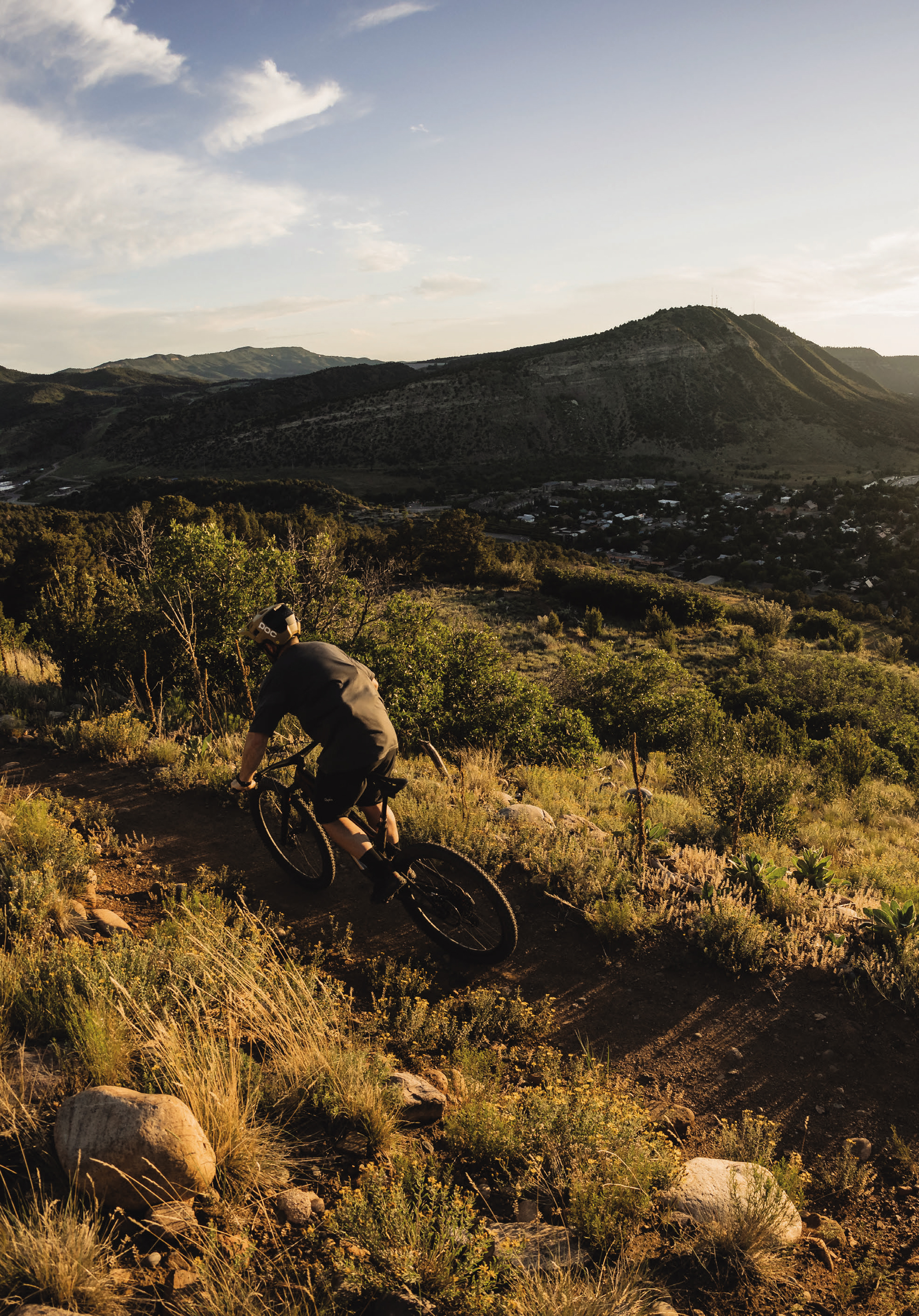
The heat was soaring and I still hadn’t really acclimatised to the altitude but, with limited time in town, the more riding the better – right?! Travis rolled over and lead the way to Overend Mountain Park, named after Ned Overend. Ned is another famous MTB local from this small biking town. The trail system consists of about 30 km of interconnected single-track trails. These trails wind through ponderosa pine forests and offer views of the surrounding landscape. The trails vary in difficulty, ranging from beginner-friendly to more challenging routes for experienced users. It leaned more towards old school MTB trails, with an XC flavour and a heap of up and down and swift sections. This soil was a little looser and didn’t offer as much grip as the other MTB parks around town. I was bloody blown as the second ride, heat and altitude got to me. I managed to nurse myself home, have a cold shower and sit on the sofa with the air-con blasting. I now had a very good lay of the land and the proximity of MTB parks that surround Durango.
The backcountry on offer is extensive and endless. I’m super energetic and wanted to cover as much high country as possible, but the reality is that I couldn’t do it all in one week. Not to mention the weather was another factor, with thunderstorms forecast. Travis was glued to weather reports and local weather guru’s and, thankfully, it looked like there would be a few days we could venture into the high country. Travis swung by in his Dodge van early the next morning. Breakfast burrito, coffees and yarns filled the hour transfer to the trail head. I opened the door of the van and could already tell the air was thinner. This was Coal Bank Pass trailhead, which sits at 3,230 metres.
Our ride would tackle the Engineer Mountain Trail located in the San Juan National Forest, about 55kms north of Durango. It’s known for its stunning views, challenging terrain, and the distinctive peak of Engineer Mountain that serves as its namesake and ultimate destination. The climb was just over 5km with an elevation gain of 600 metres, so we’d tick over 3,500 metres – which is a lot for those of us who reside at sea level! The trail takes you through diverse alpine terrain, including dense forests, open meadows filled with wildflowers, and rocky slopes as you approach the summit.
I was super excited about being in this great part of Southwest Colorado, however, my lungs weren’t feeling the same way and with every feature of the climb I would either pedal over it and run out of breath, or push over it and still run out of breath. Travis gave some words of advice – everything in slow motion, push the pedals then back off a touch at this higher altitude. This wisdom served me well and meant we could keep ascending the trail. The beauty was everywhere as we passed through forested areas and alpine meadows.
One of the most striking features of this ride is the geological formation of Engineer Mountain itself. The peak stands at 3,952 metres and is known for its unique shape — a flat-topped mountain with steep, dramatic cliffs on one side. This formation gives the mountain a distinct profile that’s visible from miles away. I was stoked I made it to this part of the ride, as it would be mostly descending from here onwards – and we could snack here and admire the view as we were above the tree line. From the top of Engineer Mountain, you are rewarded with panoramic views of the surrounding San Juan Mountains. It was a relatively clear day so we could see in every direction, taking in the rugged beauty of this part of the Colorado Rockies. The sweeping vistas from the summit made the effort all the worthwhile.
The descent was nothing short of bloody brilliant. Starting from high above the tree line the trail unfurls before you like a beautifully ribboned piece of singletrack, snaking its way down the mountainside. As you drop in, the upper section serves up some properly techy features with enough exposure for you not to peak too hard. It’s the kind of riding that demands your full attention — one wrong move and you’ll be telling the wrong kind of tales! Then comes the epic plunge into the forest. The transition is dramatic, from wide-open vistas to a green tunnel of trees. Pockets of Aspen pop up here and there, their leaves shimmering like nature’s own disco balls as you whiz past. The contrast is striking, adding another layer to the sensory overload.


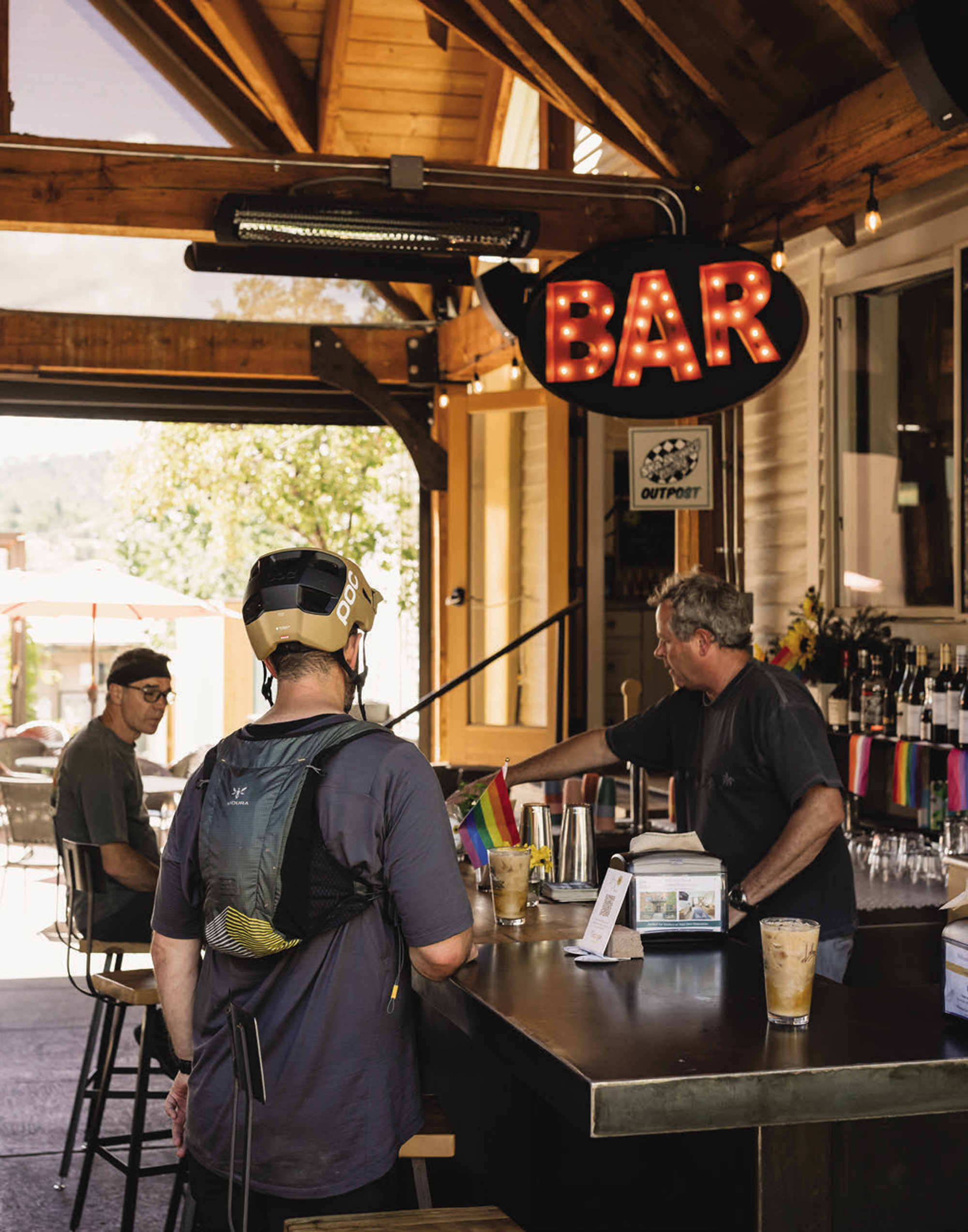
The singletrack in the woods is super tight. It keeps you on your toes, or rather, on your game. The line of sight isn’t always there, so you’re riding as much on instinct as on sight. It’s a constant cycle of react, adjust, and send it. Every corner is a new surprise, every straight a chance to let it rip before the next challenge. And oh, the dirt! It was in absolutely prime condition — the recent rain had worked its magic. The grip made me push hard into every turn.
Even though the thin mountain air has you gasping like a fish out of water – altitude is no joke — I couldn’t wipe the grin off my face. It’s the kind of run that reminds you why you fell in love with mountain biking in the first place. The blend of challenge, speed and raw natural beauty creates an intoxicating cocktail of adrenaline and endorphins. As I finally rolled to a stop at the bottom, legs burning and lungs heaving, I was already scheming about how soon I could get back up there for another go. I plonked myself in the carpark whilst Travis pedalled his way back up to the van. Its fair to say this legend was a real host, showing off that good ol’ American hospitality.
We continued that theme with an after-ride stop at James Ranch for a burger, fries and soda. James Ranch is a family-owned and operated sustainable farm nestled in the beautiful Animas Valley, this 400-acre ranch has become a local icon for its commitment to regenerative agriculture and high- quality, farm-to-table food. The burger and fries tasted great as we sat amongst the picturesque setting reflecting on the day we’d just had.
As the thunderstorms rolled in, a rest day was on the cards — and after the past few days of relentless riding, it was welcomed. It also gave me a chance to check out the town, although I had been venturing out there every night for a meal — and often yarns with the friendly locals. Durango boasts a vibrant culture that blends Old West charm with a modern, outdoorsy spirit. This small mountain town is known for its diverse culinary scene, which punches well above its weight for a city of its size. Local restaurants showcase farm-to-table ethos, often sourcing ingredients from nearby farms and ranches. It has everything from upscale bistros serving innovative Rocky Mountain cuisine to laid-back brewpubs offering craft beers paired with gourmet pub grub. The town’s culinary landscape is influenced by its proximity to New Mexico, resulting in a notable Southwestern flair in many dishes. I particularly liked these dishes and it’s just not something we get a lot of in Aotearoa. Durango’s food culture is complemented by its thriving arts scene, numerous festivals, and a strong emphasis on outdoor recreation, creating a unique blend of mountain town authenticity and cosmopolitan sophistication.
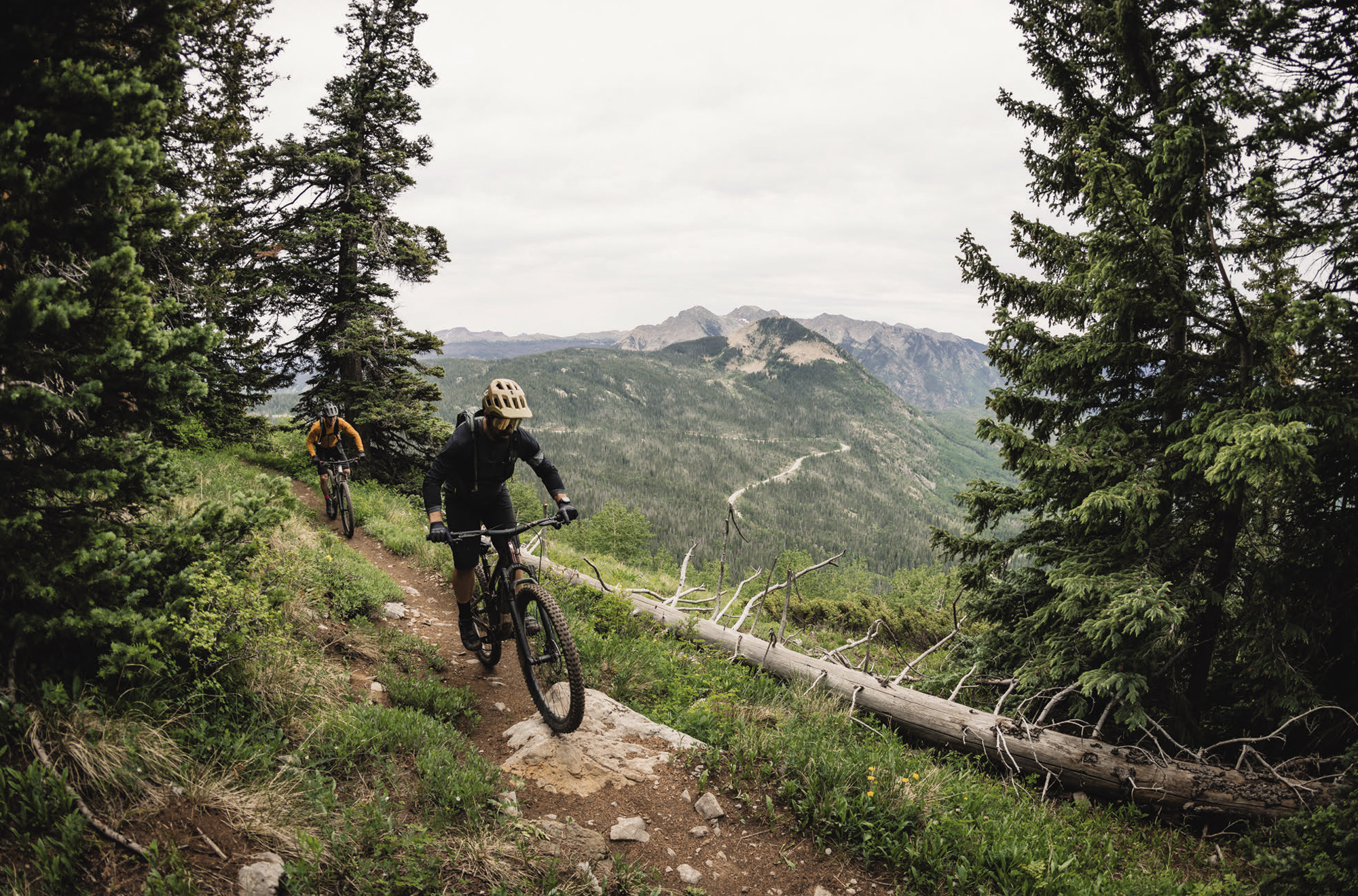
Travis pinged me and said the forecast is looking good for an early morning high country ride. I was very excited to get back up there! Travis had cleared his work backlog the previous day and was pumped about this ride. This time around we’d ride a section of the Colorado Trail. This iconic long-distance hiking and mountain biking route stretching approximately 782 km from Denver to Durango. Winding through the heart of the Rocky Mountains, this epic trail traverses eight mountain ranges, six national forests, and six wilderness areas, offering breathtaking views of Colorado’s diverse landscapes. It ranges in elevation from 1,600 metres to 4,000 metres, challenging adventurers with high-altitude terrain and unpredictable mountain weather. The trail provides a quintessential Colorado experience, showcasing alpine meadows, pristine lakes, dense forests, and rugged peaks. The plan was to tackle some of the Durango end of the trail, so we took a longish drive up an access fire road to then descend (well, mostly) back into town. Again, we were back in the high country with thin air, but it wasn’t as high as Engineer Mountain and maybe I was starting to get acclimatised?!
With the van parked, bikes unloaded, jackets zipped up, bags packed and strapped on, we dropped in. The trail was lush, a touch overgrown and a bit damp — but splendid. The thin singletrack cut its way down the mountainside allowing for high-speed sections before zigzagging back on itself. The first part of the trail went by swiftly. Before we knew it, there was a river crossing and a climb on the other side of it. The gradient was relatively good in most spots so at least I could keep my gasping lungs under control. It did take a little while, but eventually we plateaued out with a nicely placed lookout. Lunch was in order — we’d grabbed a few extra supplies from the Mexican joint we hit up before heading out. I unpacked the tinfoil to Mexican heaven in the high mountains. A few riders pulled up and we exchanged yarns. The next part was fast, fun, rowdy and quite technical in places. The trail seemed to go on for ages and my hands and feet were starting to get tired. But, I couldn’t let the fatigue stop me! I was treated to sweeping vistas of the Animas River Valley, lush alpine meadows bursting with wildflowers and dense stands of aspen and conifer forests. The trail kept winding its way down from high-altitude terrain.
This was spectacular and we bombed further down the trail, glimpses of Durango town were seen below. We reached the trailhead rather swiftly after more than two hours of mainly descending. Travis was a trooper and again pedalled back up to fetch the van which was no small feat! I pedalled back into town and stopped for a cold brew en route to Lola’s House. I will be back to ride the full Colorado Trail at some point that’s for sure!
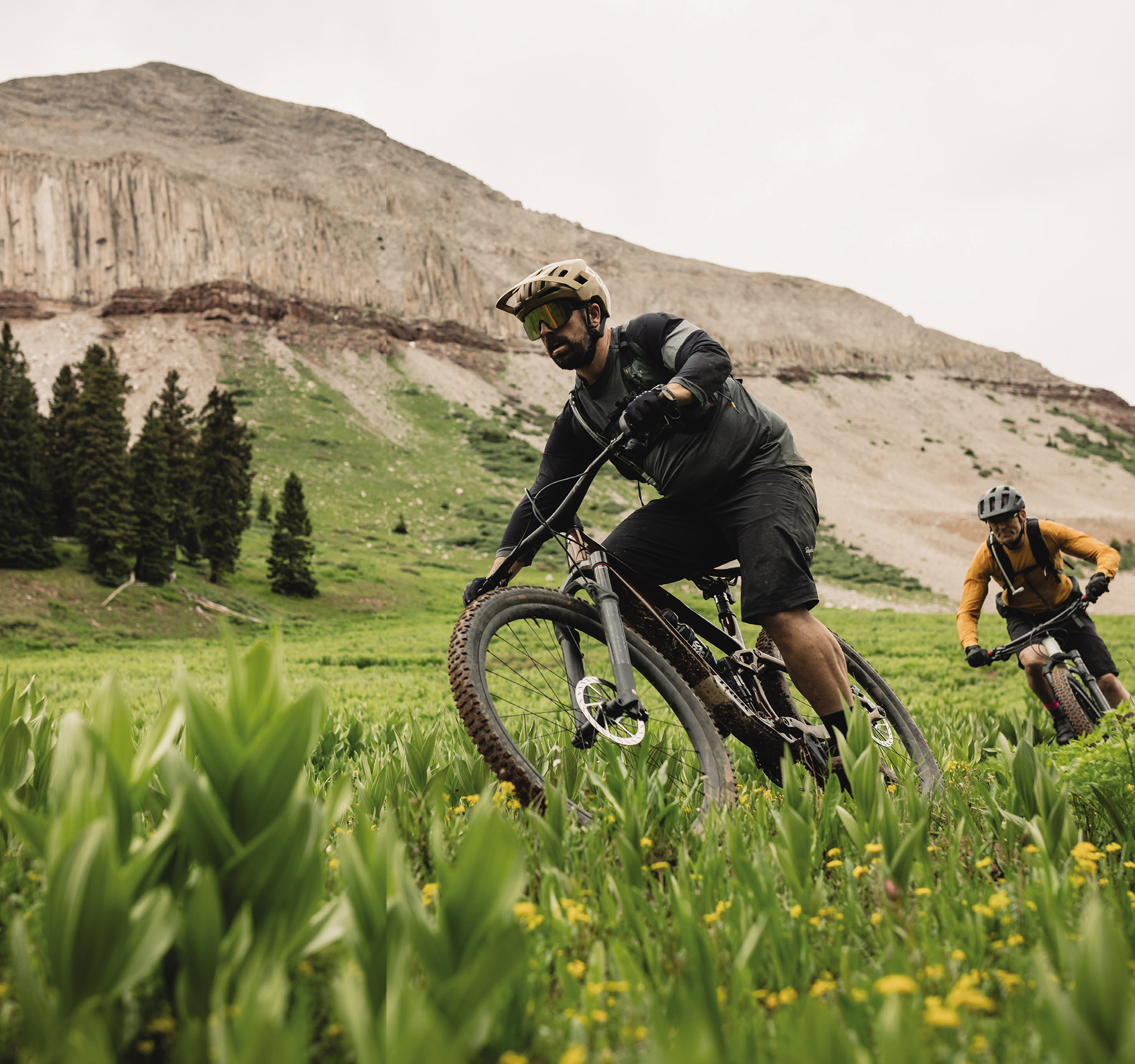
For the last few days, I hung out and rode some of the same in-town locations as earlier in the week. I was itching to get back to the high country, but the weather forecast didn’t allow for it. One last ride with Travis was around Animas Mountain, which is one local MTB park I hadn’t hit up yet. Animas High Bike Park is a relatively new addition to Durango’s impressive mountain biking scene. This purpose-built bike park offers a variety of features designed to challenge riders of different skill levels. The park includes flow trails with bermed turns and rollers, technical sections with rock gardens and drops, and a pump track for developing skills.
Each MTB Park in Durango is quite unique and this one had its own charm. I particularly liked Animas trail’s rock features which are predominantly composed of sandstone and shale, remnants of the area’s ancient seabed origins. These rocks create natural features, obstacles, and technical sections throughout the trail, which had me walking in parts whilst admiring the impeccable bike handling skills of Travis. As for the flora, Animas is characterised by a mix of pinon-juniper woodlands and ponderosa pines, interspersed with drought-resistant shrubs like sagebrush and cacti, and punctuated by colourful wildflowers in season, creating a diverse ecosystem typical of Colorado’s high desert and mountain transition zones. The vegetation is generally sparse, allowing for open sightlines on the trail — and the newly built flow trails are pretty damn fun. There’s a lot of elevation to gain and descend — as with most of Durango’s MTB parks — so ensure you pack good legs! This mix of rocky features and native plants creates a quintessential Colorado riding experience.
After more than a week in town, I finally headed to Durango Hot Springs. I looked over at the mountains as the sun was setting and was incredibly grateful that I ridden in a slither of those hills. I tried to stay present and let this moment soak in (literally). The hot springs were the perfect way to end an amazing week in Colorado’s southwest. The time spent here was made special with local legend and all-round good guy Travis Brown leading me around some of the best spots in his local hood. It really was something to hang with him, ride, eat and understand what makes up the character of this place. His in-depth knowledge of mountain biking and our shared passion for the sport made for long flowing conversations, reminding me that the bike is a great portal for human connection.
In essence, Durango offers a unique blend of historical charm, world-class trails, and a community that lives and breathes mountain biking. It’s a place where the legacy of mining has given way to a new kind of gold rush — one measured in singletrack miles and epic rides through some of Colorado’s most stunning high country.
